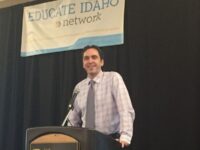About 150 educators and business leaders gathered in Boise Tuesday to promote college and career training after high school.
Educate Idaho Network’s “Igniting Education Through Partnerships” focused on the state’s goal of getting 60 percent of Idaho’s young adults to hold a postsecondary degree or certificate by 2020.
The conference attracted representatives from school districts, colleges and universities, state education agencies and local companies.
Brendalynn Love, the Jerome School District’s federal programs director and grant writer, attended to explore potential partnerships and see how different groups promote college and career education.
Love helped launch the South Central Idaho Education Partnership, inspired by Caldwell’s P-16 group. Love’s group now includes about 100 community members and organizations teaming up to promote education and to work with programs such as the College Access Challenge Grant.
“Definitely the networking (is what interested me),” Love said. “Also hearing about what is coming next is really exciting.”
Tuesday’s conference included a recap of the 2016 legislative session, an overview of college savings programs and an introduction to career-technical programs.
Carson Howell, the State Board of Education’s director of research, offered demonstrations of educational datasets.

His goal was to show how data are a tool that can improve and drive policymaking decisions.
Howell zeroed in on the success of dual-credit courses, which allow high school students to earn college credits. According to SBOE data, 71 percent of students who took dual-credit courses continued their education after high school. Conversely, only 45 percent of students who did not take dual-credit courses went on after completing high school.
Howell is also involved in developing a statewide longitudinal data system, and tracks other factors — such as the success of students who participation in STEM programs and where they chose to work after finishing their education.
“That kind of information can change the dynamic of the conversation,” Howell said.
Further reading:
- State Board of Education’s go-on data.
- Explore data on Idaho’s public schools using Idaho Ed Trends, the sister site of Idaho Education News.
